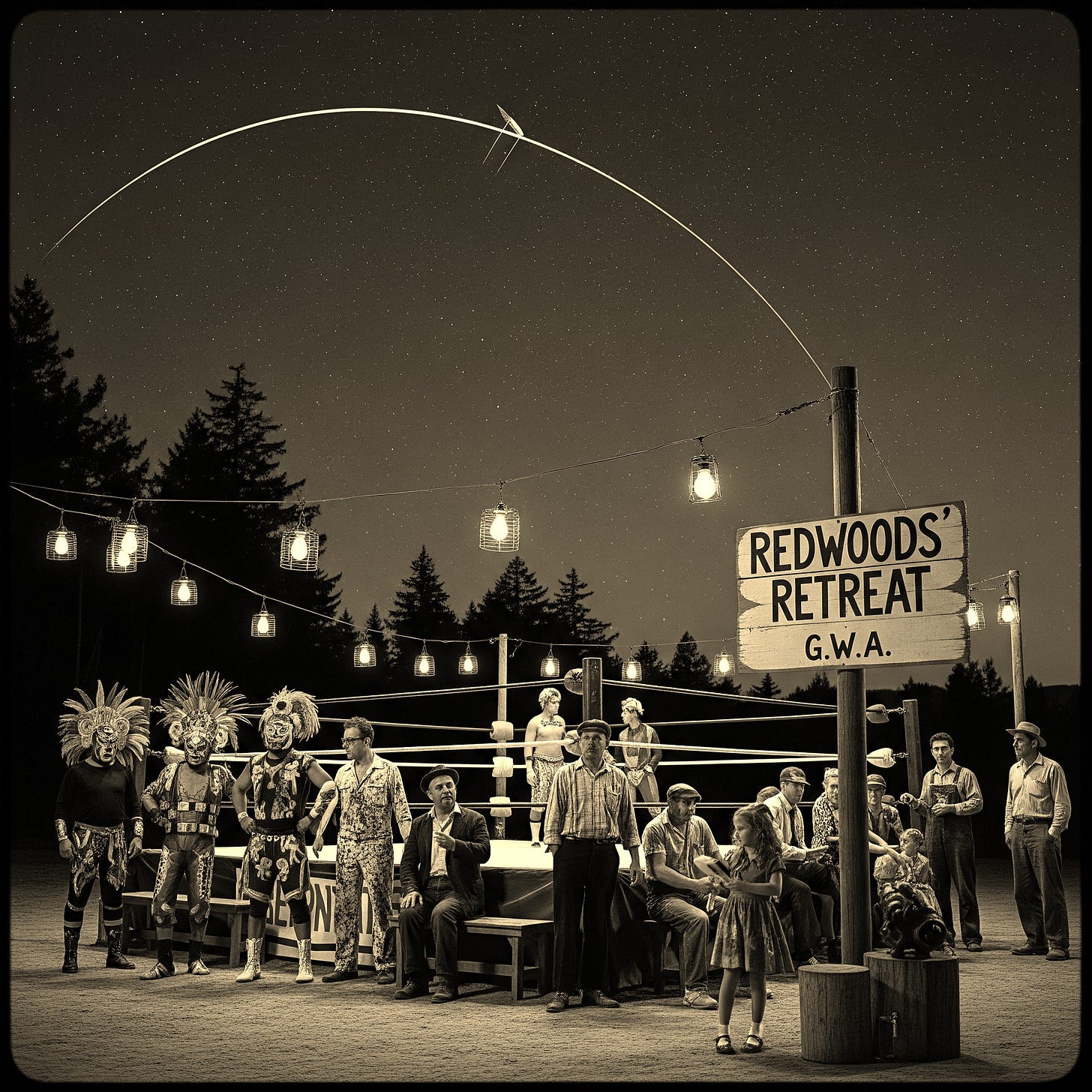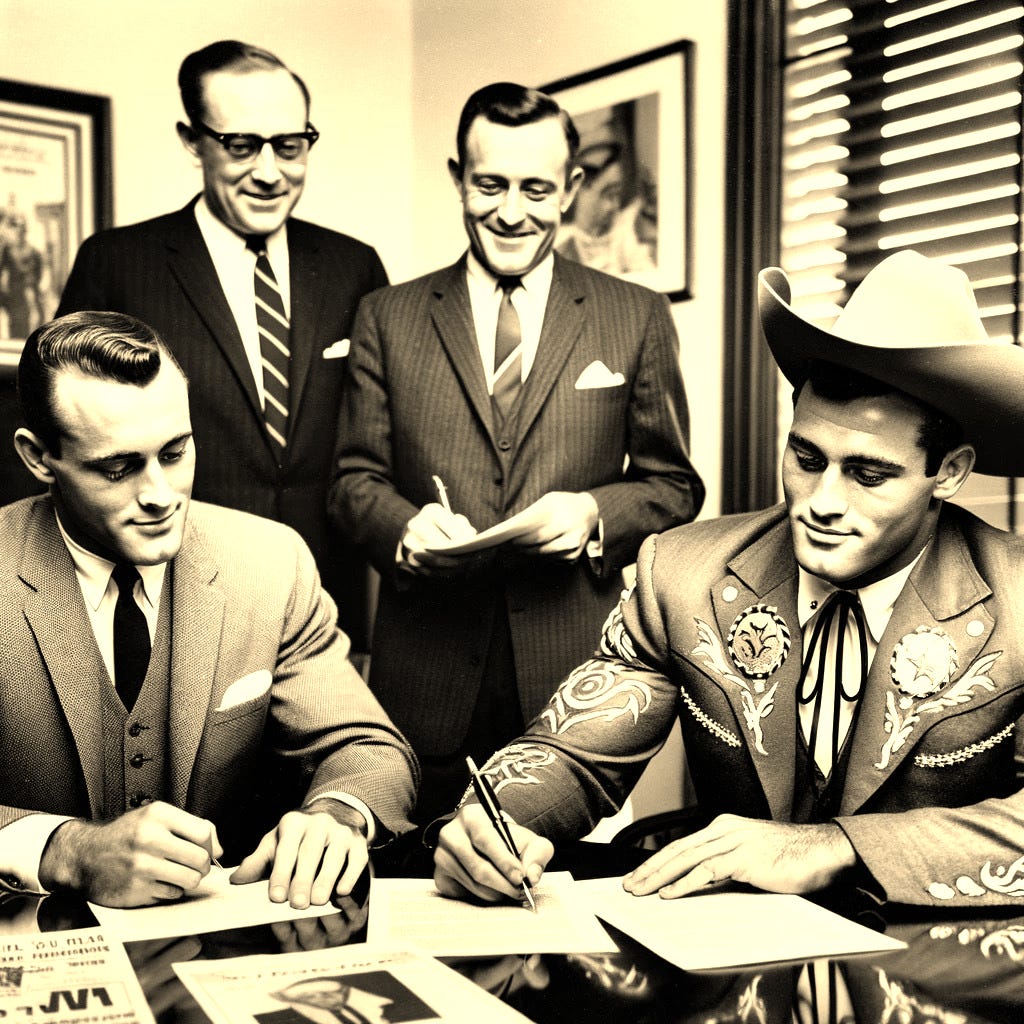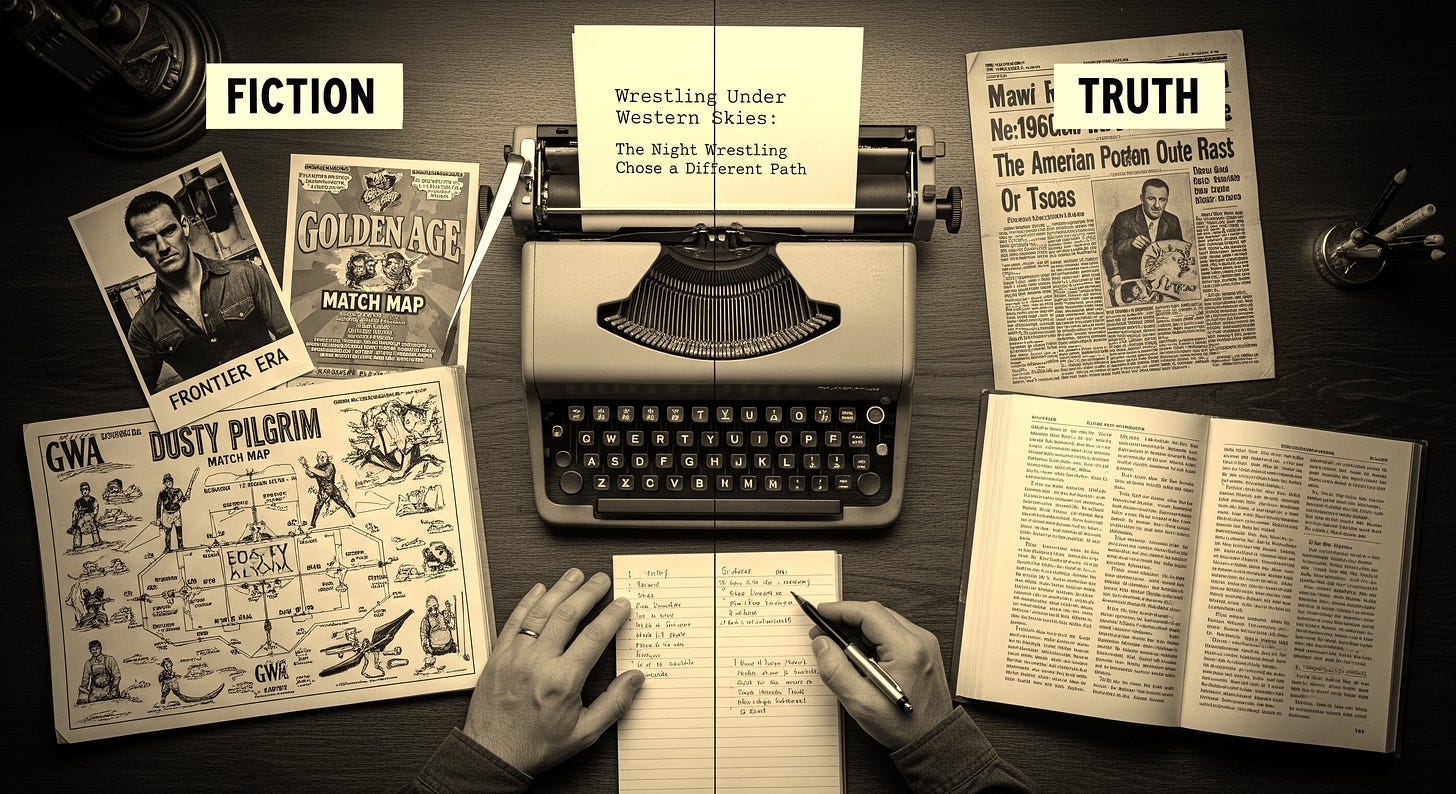The Night Pro Wrestling Chose a Different Path
One chaotic evening forced an entire sport to decide whether it would stay a carnival hustle—or grow into a frontier legend you’d follow every week.
Under South Central Texas Stars
October 4, 1957. Redwoods' Retreat, San Antonio, Texas.
The evening heat was finally breaking as Jack Carson hammered the final stake into the makeshift wrestling ring. Around him, the sprawling live oaks of South Texas stood like gnarled witnesses to what would become professional wrestling's most unlikely experiment. In a few hours, carnival wrestlers would share the canvas with Mexican luchadores while Beat poets and abstract painters watched from folding chairs borrowed from the retreat's dining hall.
Carson surveyed his handiwork with the satisfaction of a man who'd finally found a use for everything he'd learned freight-hopping across America. Seven years earlier, he'd discovered a carnival promoter's secrets hidden in a hollowed-out Bible found in a Montana boxcar. Tonight, those secrets would serve a different purpose than their original owner ever intended.
Beside him, Miguel Ramirez—who'd become his closest friend, nephew-in-law, and business partner after they'd met at Miguel’s aunt Maria's restaurant just across town—checked the ropes one final time. Both men knew this wrestling show was just another scheme to keep Redwoods' Retreat afloat. The artists' colony and roadside motel, strategically positioned near the highway on the way down to the border, had tried everything: poetry readings that charged admission, art sales to passing travelers, even housing displaced Mexican boxers fleeing the recent border boxing scandals.
But this felt different. When Ivan Gregorovich and his fellow carnival wrestlers had arrived fleeing legal troubles, they'd found the Luna Park Arena luchadores already training in the Retreat's courtyard. Carson watched carnival veterans workout with innovative Mexican wrestlers, creating an unintentional fusion that transcended both traditions.
"You think this'll actually make us money, Jack?" Ramirez asked, adjusting the lanterns that would illuminate the ring.
Carson smiled, remembering the predatory carnival wrestling system documented in that Bible. "Maybe, Miguel. But more importantly, I think we're proving it doesn't have to be that way."
Neither man could have known that while they prepared for their first wrestling show under the South Texas stars, thousands of miles away in the Soviet Union, Sputnik 1 was launching into orbit—a first volley fired in the Space Race and forever changing humanity's relationship with the heavens above.
Where Fiction Meets Truth
That conversation actually happened—in the world I've spent over a year creating.
I'm Josh Schairbaum, and the Great Western Wrestling Alliance exists as both passionate speculation and pointed criticism. Carson and Ramirez never met at the Casa Abuela Restaurant in San Antonio. No hollowed-out Bible was discovered on a Montana freight train. Redwoods' Retreat remains purely fictional.
But the date was carefully chosen. October 4, 1957, marked the launch of Sputnik 1, the moment when America suddenly realized the future had arrived ahead of schedule. While the nation grappled with its place in a rapidly changing world, I imagined two men in San Antonio launching their own small revolution—one that would prove change didn't have to mean abandonment of fundamental values.
The GWA represents speculative history at its most purposeful—not "what if Superman existed?" but "what if wrestling had chosen different values during America's moment of transformation?" This isn't nostalgia for a golden age that never was. It's cultural archaeology, examining the roads not taken in American entertainment during an era when everything seemed possible.
Wrestling has always operated where predetermined outcomes somehow reveal authentic truths. In that space, the GWA serves as both artistic experiment and alternative blueprint.
The Path Not Taken
Carson's discovery of that carnival promoter's records represents more than plot convenience—it symbolizes wrestling's original sin. From its earliest days, professional wrestling operated on a foundation of deception that extended far beyond kayfabe. Promoters exploited performers, territories engaged in predatory competition, and the entire system prioritized short-term profits over long-term sustainability.
But what if someone had chosen differently during wrestling's formative years? What if the knowledge of how wrestling really worked had fallen into the hands of people guided by different principles, at precisely the moment when America itself was questioning its assumptions about the future?
The GWA explores this possibility through the lens of two men whose backgrounds and location equipped them to see wrestling's potential differently. Carson's experience as a freight-hopping poet and veteran gave him intimate knowledge of America's overlooked communities—the very audiences territorial wrestling served. Ramirez's deep cultural connections in San Antonio provided direct access to the lucha libre traditions flowing north across the border, while Rodriguez’s aunt Maria's artistic influence brought performance art perspectives to athletic competition.
San Antonio's unique position as a cultural crossroads becomes crucial to the GWA's origin story. When the border boxing scandals of 1955 sent Mexican fighters fleeing north seeking legitimate opportunities, they naturally gravitated toward established Mexican-American communities. Redwoods' Retreat, Carson and Ramirez's struggling artists' colony, became an unexpected sanctuary where displaced luchadores could train and plan their next moves.
When carnival veterans like Ivan Gregorovich arrived separately, fleeing their own legal troubles, the stage was set for something unprecedented. As Sputnik traced its orbit overhead—though they wouldn't learn of it until the next week's newspapers—Carson and Ramirez watched two wrestling traditions blend in their courtyard training sessions. They saw cultural fusion strengthening rather than threatening their work, a lesson the real wrestling world would largely ignore for decades.
This matters because wrestling has always served as America's subconscious made manifest. In predetermined competitions that somehow feel more honest than legitimate sports, we've worked into our deepest anxieties about race, class, gender, and power. We've created modern mythologies about triumph and failure, justice and corruption, the individual versus the community.
The GWA imagines what those stories might have looked like if they'd been guided by different values from the beginning, launched at the same moment America entered the Space Age. Instead of exploiting performers fleeing economic hardship, what if wrestling had offered genuine partnership? Instead of homogenizing regional and cultural differences, what if it had celebrated the strength found in regional diversity? Instead of treating audiences as marks to be fooled, what if it had respected their intelligence during an era demanding new forms of sophistication?
This speculative history demonstrates that territorial wrestling's collapse wasn't inevitable—it resulted from choices made during a pivotal moment in American history.
Stories Across Four Decades
Each week, Wrestling Under Western Skies will chronicle the GWA's evolution from that Space Age launch night through almost four transformative decades. You'll experience their journey through eras that parallel America's own cultural evolution from the Eisenhower years through the end of the Cold War.
The Frontier Era (1957-1968) follows Carson and Ramirez as their San Antonio artists' colony experiment accidentally creates wrestling's most expansive empire. Watch them navigate the transition from handshake deals with displaced Mexican athletes to professional operations spanning thirteen territories, all while trying to maintain the principles born under Sputnik's first orbit.
The Expansion Era (1969-1975) examines how Miguel Ramirez's tragic death forced rapid evolution during America's most turbulent decade. See how Carson transformed border crossroads relationships into sophisticated business operations without compromising their founding vision.
The Golden Age (1976-1987) showcases the GWA at its peak during America's bicentennial celebration through the Cold War's final act. Experience legendary feuds that reflected cultural tensions, groundbreaking storylines that gave voice to marginalized communities, and moments when wrestling transcended entertainment to become genuine art.
The Traditions Era (1988-1993) reveals how market forces ultimately threatened everything they'd built as the Soviet Union collapsed and America faced new questions about its identity and values.
These aren't match reports—they're complete narrative experiences examining wrestling as America's most unique performance art during its most transformative decades. Free subscribers receive select stories. Paid subscribers ($5/month) access complete chronicles, including the full alternative history of wrestling's most innovative promotion, launched the same night humanity reached for the stars.
Join the Journey
That night at Redwoods' Retreat, as Sputnik began its silent orbit overhead, Carson and Ramirez launched their own small revolution. Their desperate need to keep a border town artists' colony afloat became proof that entertainment could serve community without exploiting performers, that cultural fusion strengthened artistic traditions, and that predetermined outcomes could reveal authentic truths about American dreams during the Space Age.
Their legacy lives in every story that chooses principle over profit, every moment when cultural collision becomes creative collaboration, every time community overcomes corporate interest—values as revolutionary in 1957 as that satellite racing across the October sky.
Join me as we explore this alternative history together. Subscribe to follow the journey from that first lantern-lit show under South Texas live oaks to the final bell thirty-six years later. Discover what wrestling could have been when it embraced America's cultural crossroads at the dawn of the modern age.
Welcome back to the territories. Their stories are waiting. Under these Western skies, we'll uncover wrestling's unrealized potential.
Wrestling Under Western Skies is a Great Western Productions publication. Subscribe below to begin your journey.






